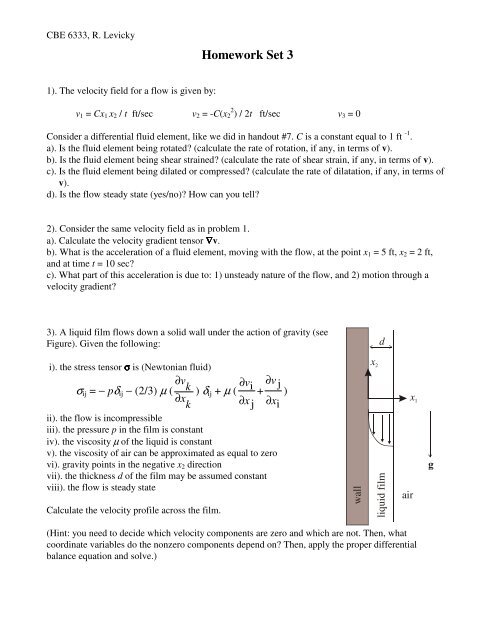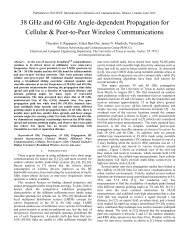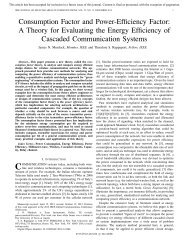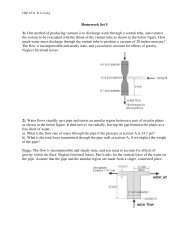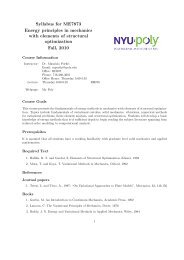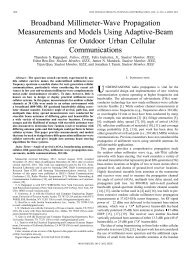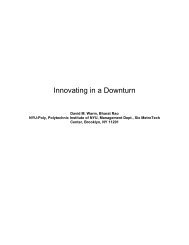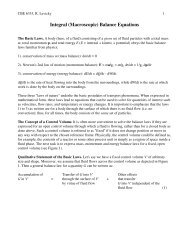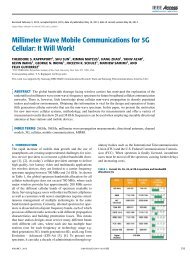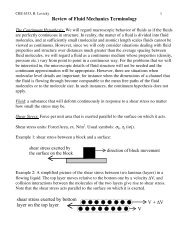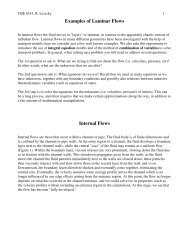Homework Set 3
Homework Set 3
Homework Set 3
- No tags were found...
Create successful ePaper yourself
Turn your PDF publications into a flip-book with our unique Google optimized e-Paper software.
CBE 6333, R. Levicky<strong>Homework</strong> <strong>Set</strong> 31). The velocity field for a flow is given by:v 1 = Cx 1 x 2 / t ft/sec v 2 = -C(x 2 2 ) / 2t ft/sec v 3 = 0Consider a differential fluid element, like we did in handout #7. C is a constant equal to 1 ft -1 .a). Is the fluid element being rotated? (calculate the rate of rotation, if any, in terms of v).b). Is the fluid element being shear strained? (calculate the rate of shear strain, if any, in terms of v).c). Is the fluid element being dilated or compressed? (calculate the rate of dilatation, if any, in terms ofv).d). Is the flow steady state (yes/no)? How can you tell?2). Consider the same velocity field as in problem 1.a). Calculate the velocity gradient tensor ∇v.b). What is the acceleration of a fluid element, moving with the flow, at the point x 1 = 5 ft, x 2 = 2 ft,and at time t = 10 sec?c). What part of this acceleration is due to: 1) unsteady nature of the flow, and 2) motion through avelocity gradient?3). A liquid film flows down a solid wall under the action of gravity (seeFigure). Given the following:i). the stress tensor σ is (Newtonian fluid)∂vσ ij = − pδ ij − (2/3) µ ( k ) δ ij + µ ( ∂ v i∂xk ∂x + ∂ jj ∂vx )iii). the flow is incompressibleiii). the pressure p in the film is constantiv). the viscosity µ of the liquid is constantv). the viscosity of air can be approximated as equal to zerovi). gravity points in the negative x 2 directionvii). the thickness d of the film may be assumed constantviii). the flow is steady stateCalculate the velocity profile across the film.wallx 2dliquid filmx 1airg(Hint: you need to decide which velocity components are zero and which are not. Then, whatcoordinate variables do the nonzero components depend on? Then, apply the proper differentialbalance equation and solve.)
CBE 6333, R. Levicky4). Consider the same flow situation as in Problem 3 (a liquid film flowing down a solid wall).a). Derive an expression for the dissipation function Φ. Note that you will need the velocity profilecalculated in problem 3.b). Calculate an expression for the rate of dissipation of mechanical energy to heat (i.e. the dissipatedpower) per unit area of the wall.c). Take d = 0.01 ft, standard value for g, and the liquid to be water at atmospheric pressure and 20 o C.Under these conditions, density of water ρ = 1.937 slugs/ft 3 and viscosity of water µ = 2.107 lb f s/ft 2 .With these data, what is the numerical value (in English units) of the dissipated power per unit area ofthe wall?5). Consider the same flow as in problem 3 (film flowing down a vertical wall). In addition toinformation provided previously, you are also given that:i). The fluid obeys Fourier's Law, with a constant heat conductivity κ.ii). There is no heat transfer by radiation or externally-coupled source of heat within the fluid.iii). Also recall that the flow is steady state, and the fluid is incompressible.iv). The temperature at the interface between the liquid film and air is fixed at T o (temperature of thesurrounding atmosphere).v). There is no heat transfer (i.e. q = 0) into the wall (this means that the wall is modeled as anadiabatic barrier - by definition, an "adiabatic" barrier is one across which no transfer of heat canoccur).a). What is the temperature profile across the liquid film? In other words, what is T(x 1 ), where T is thetemperature?b). Determine an expression for the heat flux q from the liquid film into the air. Is the heat flowing outof, or into the liquid film?c). Compare the expression for the heat flux from part b) to the expression for the dissipated powerfrom part b) of problem 4. How do the two expressions compare? Do the answers make physicalsense?6). A liquid passes through a sudden enlargement as shown in the following figure. The flow isincompressible, frictionless, steady state, the walls of the container are adiabatic (that is, no heat flowsacross them), and parameters can be identified as indicated in the Figure. For a fixed position along thepipe, the parameters (pressure, velocity, density) can be assumed uniform across the pipe cross-section(note that Port 2 is sufficiently far downstream to avoid any complications due to the enlargement thatmay invalidate this assumption). In addition, the pressure acting at port 1 can be considered uniformwith a value p 1 across the entire enlarged section, not just the actual opening (of area A 1 ) across whichflow occurs.Derive an expression for the change in internal energy per unit mass of fluid, u 2 - u 1 , in terms of v 1 , A 1 ,and A 2 only. You will need to apply all three balance laws. Note: what is the force of the walls on thefluid if the fluid is truly frictionless?
CBE 6333, R. Levickyp 1 p 2FluidFlowA , v , ρ,uA , v , ρ,u1 1 12 2 2g1 27). A slab of thickness L is subjected to microwave radiation that causes volumetric heating to varyaccording to. .(0q x)= q 1.[ − ( x L)]where q0has a constant value of 180 kW/m 3 and the slab thickness, L, is 0.06 m. The thermalconductivity of the slab material is 0.6 W/m • K. You can assume that the extent of the slab along the yand z directions is infinite.The boundary at x = L is perfectly insulated, while the surface at x = 0 is maintained at a constanttemperature of 320 K.(a) Determine an expression for T(x) in terms of x, L, k, q0, and T 0 .(b) Where, in the slab, will the maximum temperature T max occur?(c) What is the value of T max ?.


